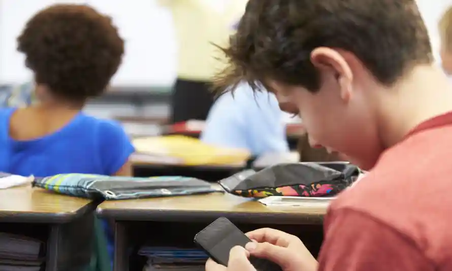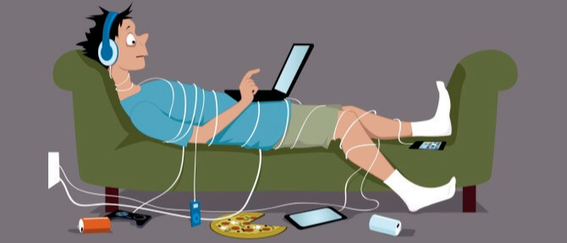Smartphones - Help or Hindrance?
by Petar Vuceta, BAPsych, GDipPsych
July 2021
by Petar Vuceta, BAPsych, GDipPsych
July 2021

Mobile smartphones are now the norm in our society and are increasingly used daily by our children and adolescents. As smartphones provide us with a convenient personal computer and are constantly increasing in their capacity and functionality, they have become an invaluable tool that we feel we can no longer live, or even leave the home, without. They allow us to access the internet, stream media, take photos and videos, and connect with people around the world via text, phone call or video. For our children and teenagers in this generation, it has opened up a whole new way to keep in touch with friends and keep up with the latest trends, however, as children are increasingly spending more time on their phones and are seemingly becoming “addicted” to this technology, there has been increasing concern amongst educators and parents about the potential impact on development, mood and anxiety.
How do you know if your child is using smartphones excessively?
The Australian Department of Health Guidelines recommends children aged between 5-17 years spend no more than 2 hours a day in total on screens for leisure use - this includes TV, gaming devices, iPads and smartphones (and is separate to screen time required for educational use). Many studies have shown that children and teenagers in Australia spend significantly more time each day on screens used for leisure. It is helpful to look for behavioural signs that may determine whether your child's smartphone use is problematic.
Excessive use of smartphones may lead to your child neglecting other important aspects of life, in preference for using their phones. It may be noticed that they begin to prefer to stay indoors and are reluctant go outside, play sports or interact with friends. You may also notice a change in their interactions at home and they may isolate themselves in their room, rather than spending time in common family areas. Another sign of excessive smartphone use is a deterioration in their academic grades at school. This is very common amongst children and adolescents when smartphone use becomes excessive (Herrero et al., 2019).
You may also notice a change in your child’s mood if they are spending too much time on their phone. They can become very withdrawn, irritable, or become angry and even resentful to their family members. Their mood may fluctuate and this can be very difficult on you, as a parent, to try to pinpoint exactly what's causing these behavioural changes (Chu et al.,2020; De-Sola Gutiérrez et al., 2016; Kiss et al, 2020).
Excessive use of smartphones may lead to your child neglecting other important aspects of life, in preference for using their phones. It may be noticed that they begin to prefer to stay indoors and are reluctant go outside, play sports or interact with friends. You may also notice a change in their interactions at home and they may isolate themselves in their room, rather than spending time in common family areas. Another sign of excessive smartphone use is a deterioration in their academic grades at school. This is very common amongst children and adolescents when smartphone use becomes excessive (Herrero et al., 2019).
You may also notice a change in your child’s mood if they are spending too much time on their phone. They can become very withdrawn, irritable, or become angry and even resentful to their family members. Their mood may fluctuate and this can be very difficult on you, as a parent, to try to pinpoint exactly what's causing these behavioural changes (Chu et al.,2020; De-Sola Gutiérrez et al., 2016; Kiss et al, 2020).
What are some things you can do to help?
If you notice these types of behaviour from your child, there are strategies that can help. It may initially seem like a good idea is to take their smartphone away from them, or drastically reduce the hours spent on their smartphones by limiting access significantly. While this may seem to be a good strategy at first, you are likely to receive some hostile feedback from your child over this. You may hear comments, such as ‘now I can’t talk to my friends’, or, ‘I'll be the unpopular one’, as they are fearful that such actions may impact their social opportunities and how they are perceived by others. They may also become resentful of you and may even display more oppositional behaviour, resulting in family conflict. When use is significantly reduced, often a child or adolescents previous reliance on their device, results in some withdrawal symptoms such as irritability, racing mind and some report they even start hearing notifications from their smartphones when there has not been any (Rodríguez-García et al 2020) (Zhang, et al , 2020)(Li & Lin, 2019).
This is because excessive use of smartphones has been linked to addictive behaviour and concerns that are seen with people with drug and alcohol addiction (Li & Lin, 2019). While the effects may not be as detrimental, the same strategies apply in order to help your child regulate their use of smartphones in a sustainable way.
This is because excessive use of smartphones has been linked to addictive behaviour and concerns that are seen with people with drug and alcohol addiction (Li & Lin, 2019). While the effects may not be as detrimental, the same strategies apply in order to help your child regulate their use of smartphones in a sustainable way.
Here are some useful tips that can help you get your child off te phone without them 'hating' you for it:
|
Responsible Smartphone Use:
- Set up clear limits for children and adolescents around appropriate use
- Here are suggestions for your child’s smartphone limits:
- What: your child must answer calls and texts, and is allowed to use their smartphone to contact friends and listen to music. They are not allowed to use their smartphones to download movies. Where age appropriate, they must ask permission to download new apps, including social media.
- Where: They can use their smartphones on the way to school, or on public transport, but when they are at home or at school it must stay in their bag.
- When: Usage during the day or in the afternoon after school is acceptable, but not between the hours of 9pm and 7am.
- Here are suggestions for household smartphone use:
- No use during family meals.
- No smartphones inside your child's bedrooms after agreed time in evening.
- Smartphone are charged in common household area.
- Smartphone are not being held during family conversations.
- Here are suggestions for your child’s smartphone limits:
- Ensure safety and be respectful of others when using the smartphone:
- Make sure profiles on social media are on private.
- Ensure the smartphone has a pin for locking.
- Do not enter any personal details, such as birth date, name, address or identifying information online.
- Only accept friends that you know face to face.
- Know which phone apps use location services and turn off unnecessary tracking so as to make sure your child is able to be tracked or contacted by nearby or unknown contacts.
While smartphones can cause stress and conflict between parents and children, with some clear limits and family boundaries, we can continue to reap the benefits from this technology in a safe and sustainable way.
References
Australian Communications and Media Authority (ACMA) (2016). Research snapshots: Australian kids and teens online. ACMA and Office of the Children’s eSafety Commissioner. Retrieved 11 June 2020 from https://www.esafety.gov.au/about-us/research/kids-teens-online.
Australian Department of Health. Australia's Physical Activity and Sedentary Behaviour Guidelines and the Australian 24-Hour Movement Guidelines. Updated Apr 2019. http://www.health.gov.au/internet/main/publishing.nsf/content/health-pubhlth-strateg-phys-act-guidelines#npa05
Chua, T.H.H., & Chang, L. (2016). Follow me and like my beautiful selfies: Singapore teenage girls’ engagement in self-presentation and peer comparison on social media. Computers in Human Behavior, 55, 190-197. doi: https://doi.org/10.1016/j.chb.2015.09.011.
Chu, H. S., Tak, Y. R., & Lee, H. (2020). Exploring psychosocial factors that influence smartphone dependency among Korean adolescents. Plos one, 15(5), e0232968
De-Sola Gutiérrez, J., Rodríguez de Fonseca, F., & Rubio, G. (2016). Cell-phone addiction: A review. Frontiers in psychiatry, 7, 175
Hefner, D., Knop, K., Schmitt, S., & Vorderer, P. (2019). Rules? Role model? Relationship? The impact of parents on their children’s problematic mobile phone involvement. Media Psychology, 22(1), 82-108. doi: 10.1080/15213269.2018.1433544.
Herrero, J., Urueña, A., Torres, A., & Hidalgo, A. (2019). Socially connected but still isolated: Smartphone addiction decreases social support over time. Social Science Computer Review, 37(1), 73-88.
Kiss, H., Fitzpatrick, K. M., & Piko, B. F. (2020). The digital divide: Risk and protective factors and the differences in problematic use of digital devices among Hungarian youth. Children and Youth Services Review, 108, 104612.
Li, L., & Lin, T. T. (2019). Over-connected? A qualitative exploration of smartphone addiction among working adults in China. BMC psychiatry, 19(1), 186
Moreno, M.A., Kerr, B.R., Jenkins, M., Lamb, E., & Malik, F.S. (2019). Perspectives on smartphone ownership and use by early adolescents. Journal of Adolescent Health, 64(4), 437-442. doi: 10.1016/j.jadohealth.2018.08.017.
RegionalTAM, OzTAM & Nielsen (2017). Australian multi-screen report, Quarter 4 2016. Sydney: RegionalTAM, OzTAM, Nielsen. Retrieved 11 June 2020 from http://www.oztam.com.au/documents/Other/Australian%20Multi%20Screen%20Report%20Q4%202016%20FINAL.pdf.
Rodríguez-García, A.-M., Moreno-Guerrero, A.-J., & López Belmonte, J. (2020). Nomophobia: An Individual’s Growing Fear of Being without a Smartphone-A Systematic Literature Review. International Journal of Environmental Research and Public Health, 17(2). https://doi.org/10.3390/ijerph17020580
Thomas, V., Azmitia, M., & Whittaker, S. (2016). Unplugged: Exploring the costs and benefits of constant connection. Computers in Human Behavior, 63, 540-548. doi: 10.1016/j.chb.2016.05.078.
Vernon, L., Modecki, K., & Barber, B.L. (2018). Mobile phones in the bedroom: Trajectories of sleep habits and subsequent adolescent psychosocial development. Child Development, 89, 66-77. doi:10.1111/cdev.12836
Zhang, Y., Lv, S., Li, C., Xiong, Y., Zhou, C., Li, X., & Ye, M. (2020). Smartphone use disorder and future time perspective of college students: the mediating role of depression and moderating role of mindfulness. Child and Adolescent Psychiatry and Mental Health, 14(1), 1-11
Australian Communications and Media Authority (ACMA) (2016). Research snapshots: Australian kids and teens online. ACMA and Office of the Children’s eSafety Commissioner. Retrieved 11 June 2020 from https://www.esafety.gov.au/about-us/research/kids-teens-online.
Australian Department of Health. Australia's Physical Activity and Sedentary Behaviour Guidelines and the Australian 24-Hour Movement Guidelines. Updated Apr 2019. http://www.health.gov.au/internet/main/publishing.nsf/content/health-pubhlth-strateg-phys-act-guidelines#npa05
Chua, T.H.H., & Chang, L. (2016). Follow me and like my beautiful selfies: Singapore teenage girls’ engagement in self-presentation and peer comparison on social media. Computers in Human Behavior, 55, 190-197. doi: https://doi.org/10.1016/j.chb.2015.09.011.
Chu, H. S., Tak, Y. R., & Lee, H. (2020). Exploring psychosocial factors that influence smartphone dependency among Korean adolescents. Plos one, 15(5), e0232968
De-Sola Gutiérrez, J., Rodríguez de Fonseca, F., & Rubio, G. (2016). Cell-phone addiction: A review. Frontiers in psychiatry, 7, 175
Hefner, D., Knop, K., Schmitt, S., & Vorderer, P. (2019). Rules? Role model? Relationship? The impact of parents on their children’s problematic mobile phone involvement. Media Psychology, 22(1), 82-108. doi: 10.1080/15213269.2018.1433544.
Herrero, J., Urueña, A., Torres, A., & Hidalgo, A. (2019). Socially connected but still isolated: Smartphone addiction decreases social support over time. Social Science Computer Review, 37(1), 73-88.
Kiss, H., Fitzpatrick, K. M., & Piko, B. F. (2020). The digital divide: Risk and protective factors and the differences in problematic use of digital devices among Hungarian youth. Children and Youth Services Review, 108, 104612.
Li, L., & Lin, T. T. (2019). Over-connected? A qualitative exploration of smartphone addiction among working adults in China. BMC psychiatry, 19(1), 186
Moreno, M.A., Kerr, B.R., Jenkins, M., Lamb, E., & Malik, F.S. (2019). Perspectives on smartphone ownership and use by early adolescents. Journal of Adolescent Health, 64(4), 437-442. doi: 10.1016/j.jadohealth.2018.08.017.
RegionalTAM, OzTAM & Nielsen (2017). Australian multi-screen report, Quarter 4 2016. Sydney: RegionalTAM, OzTAM, Nielsen. Retrieved 11 June 2020 from http://www.oztam.com.au/documents/Other/Australian%20Multi%20Screen%20Report%20Q4%202016%20FINAL.pdf.
Rodríguez-García, A.-M., Moreno-Guerrero, A.-J., & López Belmonte, J. (2020). Nomophobia: An Individual’s Growing Fear of Being without a Smartphone-A Systematic Literature Review. International Journal of Environmental Research and Public Health, 17(2). https://doi.org/10.3390/ijerph17020580
Thomas, V., Azmitia, M., & Whittaker, S. (2016). Unplugged: Exploring the costs and benefits of constant connection. Computers in Human Behavior, 63, 540-548. doi: 10.1016/j.chb.2016.05.078.
Vernon, L., Modecki, K., & Barber, B.L. (2018). Mobile phones in the bedroom: Trajectories of sleep habits and subsequent adolescent psychosocial development. Child Development, 89, 66-77. doi:10.1111/cdev.12836
Zhang, Y., Lv, S., Li, C., Xiong, Y., Zhou, C., Li, X., & Ye, M. (2020). Smartphone use disorder and future time perspective of college students: the mediating role of depression and moderating role of mindfulness. Child and Adolescent Psychiatry and Mental Health, 14(1), 1-11



